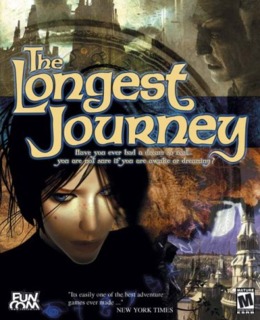An immersive tale lacking in gameplay.
The game follows April Ryan, a young woman who has run away from home to escape her father and pursue a career as an artist. Within a few months of beginning her new life in Venice April begins to have some disturbing dreams. On top of that her dreams seem to be coming to life. One day her dreams appear to her while she is awake, and many people witness strange things in town. She encounters a strange man named Cortez, who seems to have answers as to what is happening, and her journey begins.
As it turns out, the world in which she lives, a 23rd century city rife with science and technology, is but half of this world. There is another half, Arcadia, where magic reigns. Unknown to her, April has the power to “shift” between these two worlds. It turns out she has an important part to play in the coming events; a battle between those who would reunite the worlds prematurely, and those who wish to restore balance before the reunification.
TLJ has some wonderful places to explore, and the backgrounds look fantastic. Stark (the world of science) has all the infrastructure you would expect. Subways run throughout the lower city, while hover cars weave through the tall buildings of the rich upper city. The downtown is strewn with gang members, drug addicts, and other miscreants, while the outlying area is a gathering place for young artists, complete with cafe and boarding house. Arcadia, on the other hand, seems quite medieval. There are ancient structures, a bustling marketplace, a harbour, and plenty of untamed land to explore. On top of that, there are a few different species to interact with, such as the Alatian, a winged species renowned for their storytelling, and the Venar, a slow-talking people who experience past, present, and future all at the same time. Unfortunately, in terms of art, more work was put into the backgrounds than into the characters. Everyone in this game, including April, is extremely jagged, and sometimes the animations are lacking, especially when people are talking.
However stiff the characters may seem visually, the voice work in this game is great. April sounds fantastic throughout the entire game, and the other characters usually follow suit. Many of the stranger species' voices could have easily been overdone, but the developers did a great job of avoiding that problem. The dialogue is helped along by some great writing. Not only is there a very interesting story here but conversation is well written, and many characters' personalities come through clearly by talking with them. That being said, at times the dialogue drones on and on, which can get quite annoying after a while. The original score written for TLJ is another highlight. Most locations have a great theme accompanying them, be it wandering through an island forest, or riding aboard a ship at sea. The ambient sounds are also very immersive.
While the presentation of TLJ has few flaws, the gameplay is where this work really suffers. For an adventure game, TLJ contains very few puzzles to solve. Most of the time you'll have to exhaust dialogue trees until you get the information you need to continue. Also, many of the “puzzles” involve going through your inventory and trying to combine items until you find something that works. The few real puzzles either lack logic, or don't provide enough information so that they have to be solved through trial and error. As an example, at one point April is standing in front of a pedestal on which she must place a group of blocks in order to match up certain symbols. Apparently this puzzle only cares about the sides of the blocks you can actually see, because if April had been on the other side of the pedestal, the symbols would not have matched. It's truly a shame that the player should be punished for thinking in 3D when that 2D puzzle was poorly thought out.
The point-and-click interface is very intuitive to use. However, sometimes you'll be working on a puzzle for a long time, until you realize you can interact with what you thought was part of the background. Worse still is when April stands in front of the object you are trying to manipulate, so that each time you want to click on it, you have to move her out of the way first. Also, there are some areas of the game that serve no purpose other than leading to another area of the game. As nice as the backgrounds look, there's no excuse for wasting the player's time running across a screen to get to the next area.
While TLJ is a pretty cool experience, it's not much of a game. Most of your time will be spent in dialogue, and any puzzles you might encounter will likely be somewhat frustrating or unsatisfying. There's no reason this tale couldn't have been made into a book, or a cable series, but it just doesn't have enough interactivity to be a very good game. However, TLJ is now being distributed via Steam for around $10, so if you're looking for an immersive experience you might want to check it out. Don't expect much in the way of gameplay though.

